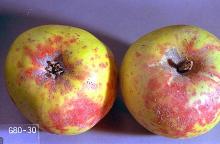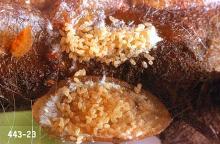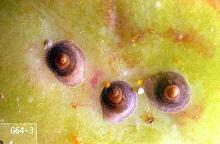Includes
European fruit lecanium scale (Parthenolecanium corni)
San Jose scale (Quadraspidiotus perniciosus)
Pest description and crop damage Lecanium scale are up to 0.2 inch across, reddish brown, and rounded. They resemble small helmets or bumps on branches, stems, and the underside of leaves. The crawlers are flat, oval, and pinkish brown. The San Jose scale is a pest of all fruit trees and many ornamental and wild trees and shrubs throughout the U.S., particularly in hot, dry climates. San Jose scale can be differentiated from other scale insects by the characters of the scale (shell) that covers the adult females. The scale is hard, gray to black, cone-shaped and less than 0.1 inch in diameter. The scale has a tiny white knob in the center with a series of grooves or rings around it. Scales are closely related to aphids, mealybugs, and whiteflies. Like these insects, they also have piercing-sucking mouthparts. Large populations of scale can devitalize plants and retard growth. Severe infestations can kill twigs. Large quantities of honeydew are produced that may cause russeting on fruit and growth of sooty mold fungus.
Biology and life history Lecanium scale overwinter as immatures on twigs and branches. They resume feeding in the spring, and eggs are laid underneath the scales in May to June. Eggs remain under the scales until hatching in early summer. The young scales, called "crawlers," migrate to the undersides of leaves to feed. Young scales also can be dispersed by wind, rain, irrigation, or by the movement of people and machinery. After 4 to 6 weeks on the leaves, the young return to the stems and twigs to feed, mate, and overwinter. There is one generation per year. The San Jose scale overwinters in an immature state and is black in color. In spring, the tiny, winged males emerge and mate with wingless females. Females give birth to live young about a month later (no eggs are produced). Crawlers are very small, flattened, and yellow, and move around on bark and foliage before settling down to feed. A few days later, they secrete a waxy coating over their body that protects them from pesticides. From this point, female scales do not move. Crawlers are found during June and July and again in August to September, so there are two generations per year.
Pest monitoring Inspect twigs during the dormant season for scales. Pay particular attention to weak plants. Observe the young bark for purplish-red halos which indicate infestation. The crawlers are best observed during June to July with a 10X magnifying glass. Crawlers can be monitored by wrapping a piece of black sticky tape around an infested branch with the sticky side out.
Management-chemical control
The best time to control scale insects, such as the San Jose scale, is during the delayed-dormant period. These applications target and smother the non-motile overwintering adult and egg stages. If spring and summer scale control is required, apply during the crawler period (June and July).
Management-chemical control: HOME USE
Dormant-season spray
Apply sprays using enough water to cover the tree thoroughly, including small limbs.
- horticultural mineral oil-Some formulations OMRI-listed for organic use.
Growing-season spray
- acetamiprid-Toxic to bees.
- azadirachtin (neem extract)-Some formulations are OMRI-listed for organic use.
- carbaryl-Highly toxic to bees.
- gamma-cyhalothrin--Highly toxic to bees.
- horticultural mineral oil-Some formulations OMRI-listed for organic use.
- imidacloprid-Peach only. Soil drenches may have residual activity in woody plants lasting for twelve or more months. If short-term management is the goal, consider other approaches.
- lambda-cyhalothrin-Highly toxic to bees.
- plant-derived essential oils-Some have shown efficacy against scale. Some formulations are OMRI-listed for organic use.
- pyrethrins-Highly toxic to bees. Some formulations are OMRI-listed for organic use.
- zeta-cypermethrin-Highly toxic to bees.
Management-chemical control: COMMERCIAL USE
Dormant and delayed-dormant spray
- horticultural mineral oil-Rates vary; check product label. REI varies; check product label. Some formulations are OMRI-listed for organic use.
- pyriproxyfen (Esteem 35WP) at 4 to 5 oz/A. REI 12 hr.
Spring and summer sprays
- diazinon (Diazinon 50W) at 1 lb plus 2 to 3 gal dormant oil or 1 to 1.5 gal superior type oil per 100 gal water per acre minimum. Do not exceed 4 lb/A per year (2 lb ai/A per year). REI 4 days. PHI 21 days. Do not apply more than 4 lb product or 6 gal oil per acre. Apply only once during the dormant season. Warning: Diazinon is hazardous to bees. Do not use during bloom or if bees are foraging in the orchard.
- pyriproxyfen (Esteem 35WP) at 4 to 5 oz/A. REI 12 hr. PHI 14 days. Pyriproxyfen is a growth regulator, with activity toward egg and immature stages only. Under heavy scale pressure, use the higher rate.





